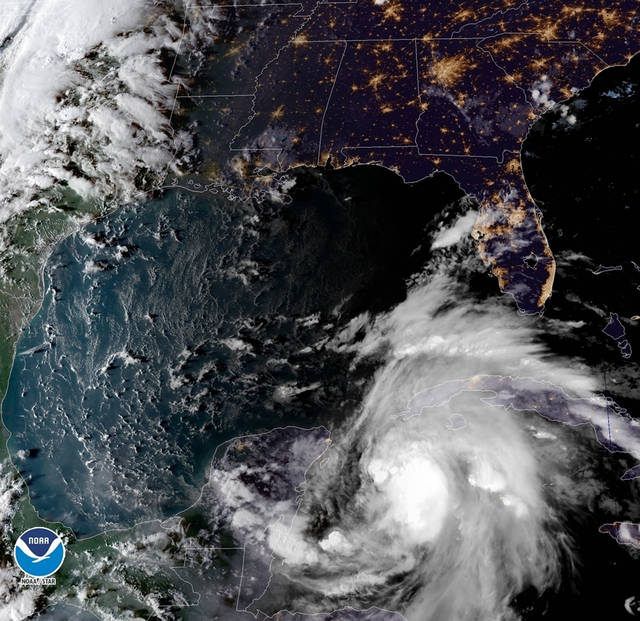MIAMI — A tropical weather system that rapidly strengthened into Hurricane Michael on Monday is likely to keep growing stronger ahead of an expected strike on Florida’s Panhandle by midweek, forecasters said.
Michael could become a major hurricane with winds topping 111 mph (178 kph) by Tuesday night before an expected strike Wednesday on the Panhandle or Big Bend, according to the National Hurricane Center.
Since the storm will spend two to three days over the Gulf of Mexico, which has very warm water temperatures and favorable atmospheric conditions, “there is a real possibility that Michael will strengthen to a major hurricane before landfall,” Robbie Berg, a hurricane specialist at the Miami-based storm forecasting hub, wrote in an advisory.
Michael’s large size, strong winds and heavy rains could produce hazardous flooding along a stretch of Florida’s Gulf coast with many rivers and estuaries where seawater pushed ashore by a hurricane could get trapped, said Hurricane Center Director Ken Graham.
“This is a part of the Gulf of Mexico that is incredibly vulnerable to storm surge,” Graham said.
Parts of Florida’s curvy Big Bend could see up to 12 feet (3.5 meters) of storm surge, while Michael also could dump up to a foot (30 centimeters) of rain over some Panhandle communities as it moves inland, forecasters said.
Mandatory evacuation orders were issued for residents of barrier islands, mobile homes and low-lying coastal areas in Gulf, Wakulla and Bay counties.
In a Facebook post Monday, the Wakulla County Sheriff’s Office said no shelters would be open because Wakulla County shelters were rated safe only for hurricanes with top sustained winds below 111 mph (178 kph). With Michael’s winds projected to be even stronger than that, Wakulla County residents were urged to evacuate inland.
“This storm has the potential to be a historic storm, please take heed,” the sheriff’s office said in the post.
A large mound of sand in Tallahassee was whittled down to a small pile within hours Monday as residents filled sandbags to prepare for potential flooding. A couple breweries in the city offered free filtered water to anyone bringing in growlers, jugs or other containers.
“All indications are that it’s going to be severe,” said City Commissioner Gil Ziffer, adding that if the storm hits Florida’s capital, there would be significant tree damage and power outages. “Hopefully we will have no one hurt and no loss of life.”
Two years ago, Hurricane Hermine knocked out power for days in Tallahassee and caused widespread flooding as it came up through the Gulf Coast. Ann Beaver was among the three-quarters of city residents who lost power after that storm. She was preparing Monday for a similar experience.
“I don’t want to lose everything in the freezer, but it is what is,” said Beaver as she loaded sandbags into her family’s pickup truck.
Tallahassee Mayor Andrew Gillum, who is the Democratic nominee for governor, had planned to campaign in South Florida on Monday and Tuesday, but he said he would return to the city to help with storm preparations.
Florida State University and Leon County schools canceled classes from Tuesday through Friday.
Farther west along Florida’s Panhandle, the city of Pensacola tweeted to residents, “Be sure you have your emergency plan in place.”
By 5 p.m. Monday, Michael’s top sustained winds were around 80 mph (130 kph) as it headed north at 9 mph (15 kph).
The storm was centered about 30 miles (45 kilometers) off the western tip of Cuba, and about 520 miles (835 kilometers) south of Apalachicola, Florida. Hurricane-force winds extend outward up to 35 miles (55 kilometers) from the storm’s center and tropical-storm-force winds extend outward up to 175 miles (280 kilometers).
Michael was lashing western Cuba late Monday morning with heavy rains and strong winds, according to the hurricane center. Forecasters warned that the storm could produce up to a foot (30 centimeters) of rain in western Cuba, potentially triggering flash floods and mudslides in mountainous areas.
Florida Gov. Rick Scott issued an order for a state of emergency for 35 counties, from the Panhandle through to Tampa Bay, to rush preparations, freeing up resources and activating 500 members of the Florida National Guard.
Aside from causing power outages, flooding and property damage, Michael could also worsen a toxic algae bloom that has plagued Florida’s beaches for a year.
The red tide in the Gulf of Mexico off southwest Florida that began last October after Hurricane Irma swept up the state has killed massive amounts of marine life and caused respiratory irritations in people. The bloom has spread to Florida’s Panhandle and the Miami area.
Tracy Fanara at Mote Marine Laboratory and Aquarium in Sarasota said the algae are “very vulnerable to turbulence” and the bloom could dissipate. However, Fanara said, Michael’s strong winds also could stir up pollution and nutrients in the water that feed algae blooms.
Michael was expected to make landfall Wednesday in parts of the Panhandle where county jail inmates were enlisted last week to help clean up fish killed by the red tide.
———
Fineout reported from Tallahassee, Florida.



